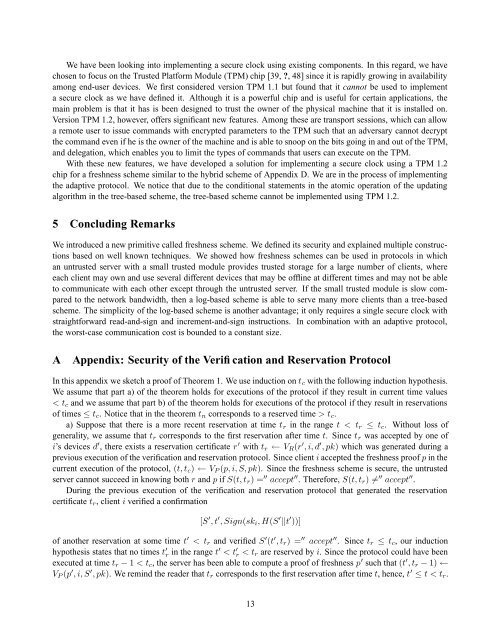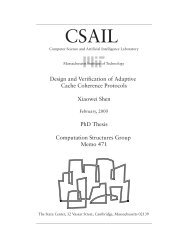Proof of Freshness - Computation Structures Group - MIT
Proof of Freshness - Computation Structures Group - MIT
Proof of Freshness - Computation Structures Group - MIT
You also want an ePaper? Increase the reach of your titles
YUMPU automatically turns print PDFs into web optimized ePapers that Google loves.
We have been looking into implementing a secure clock using existing components. In this regard, we have<br />
chosen to focus on the Trusted Platform Module (TPM) chip [39, ?, 48] since it is rapidly growing in availability<br />
among end-user devices. We first considered version TPM 1.1 but found that it cannot be used to implement<br />
a secure clock as we have defined it. Although it is a powerful chip and is useful for certain applications, the<br />
main problem is that it has is been designed to trust the owner <strong>of</strong> the physical machine that it is installed on.<br />
Version TPM 1.2, however, <strong>of</strong>fers significant new features. Among these are transport sessions, which can allow<br />
a remote user to issue commands with encrypted parameters to the TPM such that an adversary cannot decrypt<br />
the command even if he is the owner <strong>of</strong> the machine and is able to snoop on the bits going in and out <strong>of</strong> the TPM,<br />
and delegation, which enables you to limit the types <strong>of</strong> commands that users can execute on the TPM.<br />
With these new features, we have developed a solution for implementing a secure clock using a TPM 1.2<br />
chip for a freshness scheme similar to the hybrid scheme <strong>of</strong> Appendix D. We are in the process <strong>of</strong> implementing<br />
the adaptive protocol. We notice that due to the conditional statements in the atomic operation <strong>of</strong> the updating<br />
algorithm in the tree-based scheme, the tree-based scheme cannot be implemented using TPM 1.2.<br />
5 Concluding Remarks<br />
We introduced a new primitive called freshness scheme. We defined its security and explained multiple constructions<br />
based on well known techniques. We showed how freshness schemes can be used in protocols in which<br />
an untrusted server with a small trusted module provides trusted storage for a large number <strong>of</strong> clients, where<br />
each client may own and use several different devices that may be <strong>of</strong>fline at different times and may not be able<br />
to communicate with each other except through the untrusted server. If the small trusted module is slow compared<br />
to the network bandwidth, then a log-based scheme is able to serve many more clients than a tree-based<br />
scheme. The simplicity <strong>of</strong> the log-based scheme is another advantage; it only requires a single secure clock with<br />
straightforward read-and-sign and increment-and-sign instructions. In combination with an adaptive protocol,<br />
the worst-case communication cost is bounded to a constant size.<br />
A Appendix: Security <strong>of</strong> the Verification and Reservation Protocol<br />
In this appendix we sketch a pro<strong>of</strong> <strong>of</strong> Theorem 1. We use induction on tc with the following induction hypothesis.<br />
We assume that part a) <strong>of</strong> the theorem holds for executions <strong>of</strong> the protocol if they result in current time values<br />
< tc and we assume that part b) <strong>of</strong> the theorem holds for executions <strong>of</strong> the protocol if they result in reservations<br />
<strong>of</strong> times ≤ tc. Notice that in the theorem tn corresponds to a reserved time > tc.<br />
a) Suppose that there is a more recent reservation at time tr in the range t < tr ≤ tc. Without loss <strong>of</strong><br />
generality, we assume that tr corresponds to the first reservation after time t. Since tr was accepted by one <strong>of</strong><br />
i’s devices d ′ , there exists a reservation certificate r ′ with tr ← VR(r ′ , i, d ′ , pk) which was generated during a<br />
previous execution <strong>of</strong> the verification and reservation protocol. Since client i accepted the freshness pro<strong>of</strong> p in the<br />
current execution <strong>of</strong> the protocol, (t, tc) ← VP (p, i, S, pk). Since the freshness scheme is secure, the untrusted<br />
server cannot succeed in knowing both r and p if S(t, tr) = ′′ accept ′′ . Therefore, S(t, tr) = ′′ accept ′′ .<br />
During the previous execution <strong>of</strong> the verification and reservation protocol that generated the reservation<br />
certificate tr, client i verified a confirmation<br />
[S ′ , t ′ , Sign(ski, H(S ′ ||t ′ ))]<br />
<strong>of</strong> another reservation at some time t ′ < tr and verified S ′ (t ′ , tr) = ′′ accept ′′ . Since tr ≤ tc, our induction<br />
hypothesis states that no times t ′ r in the range t′ < t ′ r < tr are reserved by i. Since the protocol could have been<br />
executed at time tr − 1 < tc, the server has been able to compute a pro<strong>of</strong> <strong>of</strong> freshness p ′ such that (t ′ , tr − 1) ←<br />
VP (p ′ , i, S ′ , pk). We remind the reader that tr corresponds to the first reservation after time t, hence, t ′ ≤ t < tr.<br />
13
















